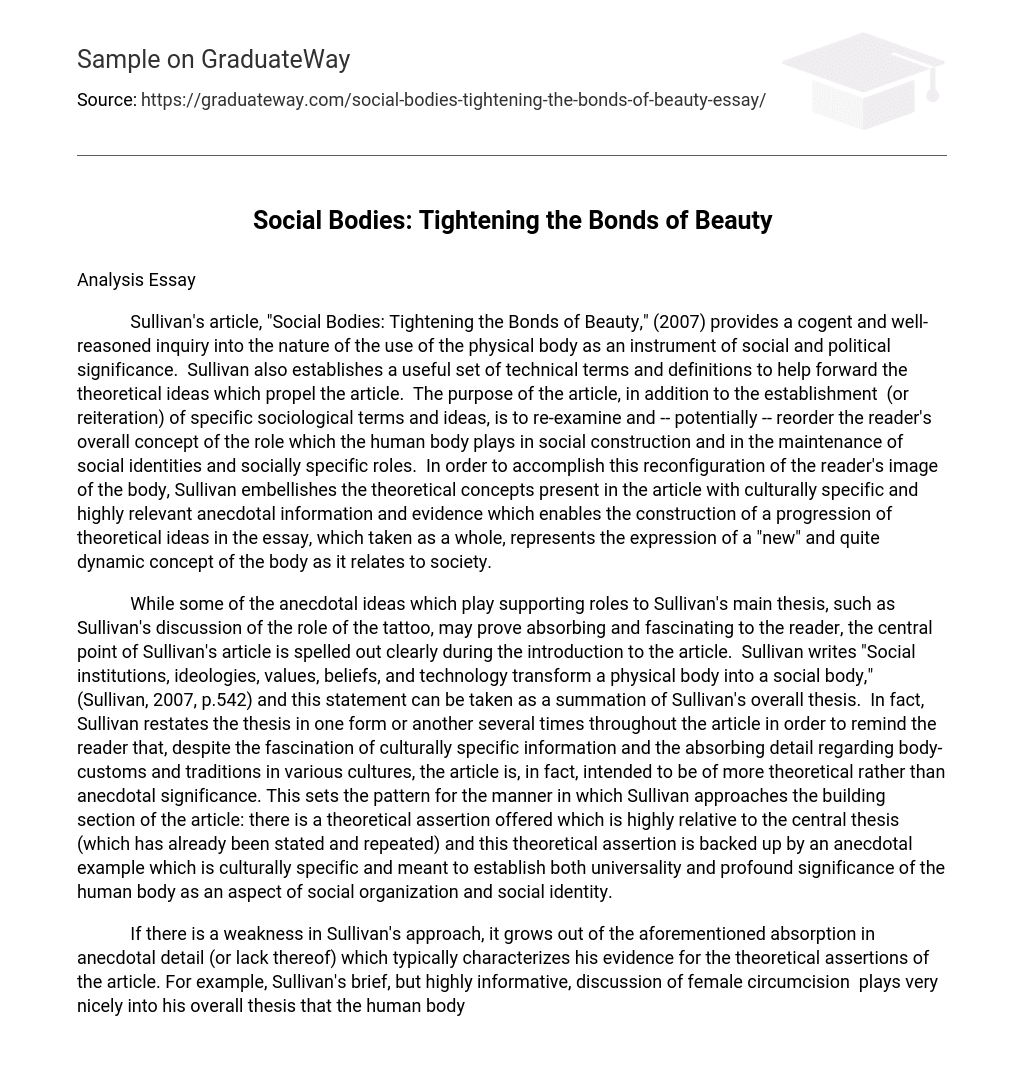Sullivan’s article, “Social Bodies: Tightening the Bonds of Beauty,” (2007) provides a cogent and well-reasoned inquiry into the nature of the use of the physical body as an instrument of social and political significance. Sullivan also establishes a useful set of technical terms and definitions to help forward the theoretical ideas which propel the article. The purpose of the article, in addition to the establishment (or reiteration) of specific sociological terms and ideas, is to re-examine and – potentially – reorder the reader’s overall concept of the role which the human body plays in social construction and in the maintenance of social identities and socially specific roles.
In order to accomplish this reconfiguration of the reader’s image of the body, Sullivan embellishes the theoretical concepts present in the article with culturally specific and highly relevant anecdotal information and evidence which enables the construction of a progression of theoretical ideas in the essay, which taken as a whole, represents the expression of a “new” and quite dynamic concept of the body as it relates to society.
While some of the anecdotal ideas which play supporting roles to Sullivan’s main thesis, such as Sullivan’s discussion of the role of the tattoo, may prove absorbing and fascinating to the reader, the central point of Sullivan’s article is spelled out clearly during the introduction to the article. Sullivan writes “Social institutions, ideologies, values, beliefs, and technology transform a physical body into a social body,” (Sullivan, 2007, p.542) and this statement can be taken as a summation of Sullivan’s overall thesis.
In fact, Sullivan restates the thesis in one form or another several times throughout the article in order to remind the reader that, despite the fascination of culturally specific information and the absorbing detail regarding body-customs and traditions in various cultures, the article is, in fact, intended to be of more theoretical rather than anecdotal significance.
This sets the pattern for the manner in which Sullivan approaches the building section of the article: there is a theoretical assertion offered which is highly relative to the central thesis (which has already been stated and repeated) and this theoretical assertion is backed up by an anecdotal example which is culturally specific and meant to establish both universality and profound significance of the human body as an aspect of social organization and social identity.
If there is a weakness in Sullivan’s approach, it grows out of the aforementioned absorption in anecdotal detail (or lack thereof) which typically characterizes his evidence for the theoretical assertions of the article. For example, Sullivan’s brief, but highly informative, discussion of female circumcision plays very nicely into his overall thesis that the human body is “a site for the expression of power in a culture” (Sullivan, 2007, p.542) but Sullivan fails not only to cite specific cultures or time-periods where female circumcision plays a role, but fails to identify any specific culture or race or even geographical region at all, referring instead to “these traditional cultures” (Sullivan, 2007, p.542).
While the culturally specific practice of female circumcision is an excellent bit of evidence to cite in support of the article’s overall thesis, Sullivan’s generalization, probably more an aspect of authorial style than negligence, could be convincingly raised as a potential objection to the article’s strength of persuasion.
In fact, the pattern described above, while potentially hazardous from a strictly critical viewpoint is a very effective pattern for Sullivan to employ in the article which, as mentioned, is theoretically dense and engaging, but quite brief. This means that Sullivan needed to devise a way to demonstrate the universality of the body-as-social-expression while simultaneously informing the reader about the culturally specific ways in which this universal tendency found expression.
The consequence would seem to be, not a concise (and therefore more immediately persuasive) article. but a sprawling, massive inquiry into comparative cultural studies. Therefore, Sullivan’s use of culturally specific, but anecdotal evidence, in combination with theoretical demanding ideas is a good match. The result is that, due to the far-ranging citation of culturally specific information and customs which are not bogged down by lengthy statistics or dry background information, the reader feels the sense of universality because Sullivan has presented the reader with a wide-ranging set of cultural practices and cultures all of which support the central assertion that the human body functions as an instrument of social cohesion and social order while simultaneously being acted upon by the social order in which it exists.
Interestingly, Sullivan’s ability to build tension in the essay stems from this same contrast of theoretical postulation (and definition) with culturally specific information and anecdotal evidence. Without such a balance, it is entirely possible that Sullivan would “lose” many readers in the complex theoretical ideas which are compressed in the essay and – correspondingly – without the technical and theoretical ideas, the anecdotal information of comparative cultural practices would devolve into a series of unrelated but quite interesting passages about cultural practices in various parts of the world which were associated with the human body.
Instead, by framing the thesis with both theory and relevant “asides,” Sullivan manages to create an absorbing and very comprehensible article out of what might otherwise prove to be very dry and therefore inordinately challenging set of theoretical assertions. The approach used by Sullivan in the article is both effective and creative although, as mentioned, the contrast between the theoretical aspects and the anecdotal aspects of the article can sometimes feel a bit too abrupt. Overall, Sullivan’s article is highly effective and quite persuasive.
References
- Sullivan, Deborah Anne. (2007) Social Bodies: Tightening the Bonds of Beauty. Strategies for Successful Writing. Pearson: Prentice Hall.





